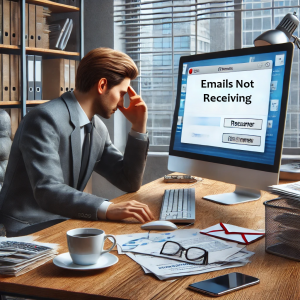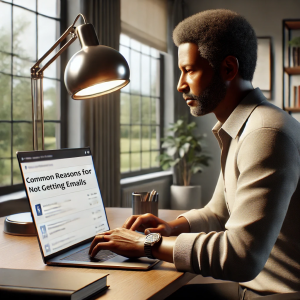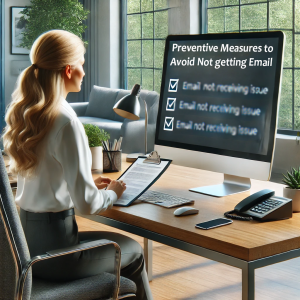Email Not Receiving
In today’s digital world, email stands as a cornerstone of professional and personal communication. It’s the conduit through which we receive vital information, ranging from business decisions and job offers to personal messages and event invitations. Hence, the seamless operation of email services is crucial for maintaining the flow of daily communications.
However, issues such as Email Not Receiving can significantly disrupt this flow, leaving individuals and businesses alike in a precarious position. Many users find themselves puzzled and frustrated when they cannot receive emails. Whether it’s missing out on critical contract details or not receiving an expected greeting from a loved one, the impact is felt deeply. Situations where you are unable to receive emails can stem from various technical glitches or misconfigurations, often leaving users feeling helpless.
Among the specific issues encountered, some users report they are not receiving emails from one person specifically or from multiple senders. Additionally, the general problem of not getting emails you were expecting can be a sign of deeper issues within your email setup.
The purpose of this blog is to address these common but distressing problems. Through this series, we aim to assist you through the necessary steps to diagnose and resolve issues related to not receiving emails. Whether your problem is broad or specific, our goal is to restore your communication line and ensure that your email system works flawlessly, enhancing both your personal interactions and professional engagements.
Stay tuned as we look into the intricacies of email systems, explore common pitfalls, and walk you through both basic and advanced troubleshooting techniques to help you reclaim your digital lifeline.
Understanding Email Systems
To effectively tackle issues such as not getting emails, it’s crucial to have a foundational understanding of how email systems operate. The backbone of these systems is based on protocols such as SMTP (Simple Mail Transfer Protocol), POP3 (Post Office Protocol), and IMAP (Internet Message Access Protocol). Each of these plays a pivotal role in the seamless delivery and management of your emails.
SMTP is mainly responsible for sending emails from your device to the email server and from there to the recipient’s email server. If there’s an issue in the SMTP settings, it might lead to situations where you cannot receive emails or cause your messages to go unsent.
On the other hand, POP3 and IMAP are used for retrieving emails from your server. While POP3 downloads emails from the server for permanent local storage, IMAP allows multiple devices to access the same mailbox, making it highly suitable for today’s multi-device world. If your IMAP settings are incorrect, you may find yourself unable to receive emails consistently across your devices.
Additionally, the correct incoming server settings are essential to ensure that your email application can correctly interact with the email server to download or access your messages. Incorrect incoming server settings or IMAP server settings can be the reason why you are not receiving emails from one person or why emails are not being received at all.
Understanding these settings and ensuring they are correctly configured is crucial for anyone facing issues like Email Not Receiving. It’s not just about resolving current issues but also about preventing future disruptions in your email communication. This understanding will serve as your first line of defense against common problems that prevent emails from reaching your inbox.
Common Reasons for Not Getting Emails
Encountering issues like Email Not Receiving can be frustrating, especially when the reasons are not immediately apparent. Understanding the common culprits behind why you cannot receive emails can be the key to solving these disruptions. Here we delve into various factors that might be preventing your emails from arriving in your inbox.
-
Email Account Problems:
-
Incorrect Email Configuration:
If your email settings are not configured correctly, particularly your incoming server settings, this could easily result in you being unable to receive emails. Ensure that your SMTP, POP3, and IMAP settings are set up according to your provider’s specifications.

-
Full Inbox:
A less considered but common issue is an inbox that has reached its capacity limit. Once full, it will prevent any new emails from being received, which means you could be not getting emails without even realizing this simple cause.
-
-
Server Issues:
-
Server Downtime:
Occasionally, the email server itself might be down. During these periods, you will experience delays or a complete halt in email delivery, leading to complaints of emails not being received.
-
Delays in Email Delivery:
Sometimes, emails are not lost but merely delayed. Server overload or maintenance can delay email delivery, which might seem like you are not receiving emails from one person or multiple senders.
-
Emails Mistakenly Marked as Spam:
One of the most common reasons for Email Not Receiving issue is when legitimate emails are incorrectly flagged as spam. Regularly checking your spam folder could reveal that the emails you thought you weren’t receiving were misfiled by overly aggressive spam filters.
-
Sender’s Email Address Blocked Unintentionally:
If a sender’s email address has been accidentally added to your block list, their emails will not appear in your inbox. This often happens without the user’s knowledge, contributing to the issue of not receiving emails from one person.
-
Internet Connectivity Issues:
Simple yet often overlooked, lack of reliable internet access is a fundamental barrier to receiving emails. If your device cannot connect to the internet, your email client won’t be able to fetch new messages from the server.
-
By addressing these common causes, you can mitigate the frustration of Email Not Receiving and enhance your overall email experience.
Basic Troubleshooting Steps for Email Not Receiving Issues
When you find yourself saying that you are not getting emails, it can be both perplexing and frustrating. Before looking into more complex solutions, there are some basic troubleshooting steps you can take to address common issues related to Email Not Receiving. These steps are designed to resolve the most frequent problems that prevent emails from reaching your inbox.
-
Checking Internet Connection:
-
Ensuring Stable and Active Internet Connectivity:
A reliable internet connection is foundational to receiving emails. If your connection is unstable or disconnected, you will inevitably experience issues with not getting emails. Verify that your device maintains a strong and stable connection. You can quickly verify this by attempting to browse the internet or send an instant message.
-
-
Inspecting Spam Folder:
-
Looking for Emails Wrongly Categorized as Spam:
One of the simplest reasons you might be unable to receive emails, particularly from one person, is that their messages are being directed to your spam folder. Check this folder regularly to ensure no important emails are being misclassified.
-
-
Reviewing Email Settings:
-
Verifying Server Settings (SMTP, POP3, IMAP):
Incorrect IMAP settings, IMAP server settings, or incoming server settings can disrupt your ability to receive emails. Access your email settings and verify that all server addresses, ports, and authentication methods match those provided by your email service. This step is crucial if you are experiencing continual issues with emails not being received.
-
Ensuring the Email Account is Not Full:
Another overlooked issue is a full inbox. Many email providers limit the amount of data you can store. If your inbox is full, new emails will be bounced back to the sender. Make sure you have enough space by deleting old or unnecessary emails and emptying the trash.
-
-
Checking Email on Different Devices:
-
Using Webmail or Different Devices to Access Emails:
Sometimes, the problem might be with your primary device. To rule out device-specific issues, try accessing your emails through a web browser or a different device. This can help identify if the problem is with your email client or the device itself.
-
These basic steps are often enough to resolve common problems associated with Email Not Receiving. By methodically going through these checks, you can usually pinpoint and correct the issue, restoring your email functionality and ensuring you do not miss out on important communications.
Advanced Troubleshooting for Resolving Email Not Receiving Issue
When basic troubleshooting fails to resolve issues like Email Not Receiving or when you consistently cannot receive emails, it may be necessary to delve into more advanced troubleshooting techniques. These methods are designed to tackle deeper technical issues that might be hindering your email flow, particularly when you are not getting emails despite all settings appearing correct.
-
Verifying MX Records and DNS Settings:
MX (Mail Exchange) records are a vital part of your domain’s DNS (Domain Name System) settings that direct email to your mail servers. Incorrect MX record configuration can lead to problems where you are unable to receive emails. Use DNS lookup tools to verify that your domain’s MX records are correctly pointing to your email provider’s servers. Also, ensure that your DNS settings are not causing any disruptions in your email service.
-
Checking Server Logs for Any Incoming Connection Blocks:
Server logs can provide invaluable insights into various issues that affect email reception. By analyzing these logs, you can identify if your server is blocking incoming connections possibly due to security settings or IP blacklisting. This analysis is particularly useful if you are not receiving emails from one person or specific domains, as it can reveal whether their messages are being rejected at the server level.
-
When to Contact Your IT Department or Service Provider for Help:
Sometimes, the issues extend beyond what can be diagnosed and resolved with user-level access. If your IMAP server settings and incoming server settings are correct, and you’ve conducted DNS and log checks without resolution, it’s time to seek professional help. Contact your IT department or email service provider if you continue experiencing issues with emails not being received. They can provide more advanced diagnostics and possibly identify and fix server-side issues that are not visible to end users.
Employing these advanced troubleshooting techniques requires a deeper understanding of how email systems work, but they are crucial in resolving persistent or complex issues. Whether it’s a misconfigured server or a subtle network issue, these steps help ensure that every aspect of your email infrastructure is functioning correctly, restoring your ability to reliably receive email communications.
Preventive Measures to Avoid Not getting Email
Ensuring consistent and reliable email delivery involves proactive steps to prevent issues where you are not getting emails. By implementing these preventive measures, you can maintain the health of your email account and mitigate common problems that disrupt email communication.
-
 Regular Account Maintenance:
Regular Account Maintenance:-
Regularly Updating Passwords:
Strong, updated passwords are important for securing your email account from unauthorized access, which can sometimes lead to altered settings or blocked communications.
-
Clearing Inbox Space:
Regularly manage your email storage by deleting old or unwanted emails and emptying the trash. This prevents the common problem of a full inbox, which stops new emails from being received.
-
Setting Up Alerts:
Many email services allow you to set up alerts that notify you when an email is not delivered. This feature is particularly useful for business accounts where missing an email can have significant repercussions. These alerts can act as an early warning system, asking for immediate action when emails are not being received.
-
Best Practices for Managing Spam Filters:
While spam filters are necessary for keeping unwanted emails out, they can sometimes be too aggressive. Educate yourself and your team on how to properly configure these filters to prevent legitimate emails from being mislabeled as spam. Regularly reviewing your spam folder is a simple yet effective practice to ensure you are not missing emails due to overly strict filtering.
-
Keeping Email Clients and Security Systems Updated:
Software updates often include patches for security vulnerabilities and improvements in performance. Ensuring that your email client and any associated security programs are up-to-date is critical. Outdated software can lead to suitability issues or security risks that might prevent you from receiving emails.
-
By adhering to these preventive measures, you can greatly reduce the risk of encountering problems such as unable to receive emails or issues with your IMAP server settings and incoming server settings. Regular maintenance, vigilant monitoring, and ongoing education about email management are your best defenses against disruptions in your email communications. These practices not only enhance your security but also ensure that your communication lines remain open and efficient.
FAQs
Q1. Why am I not getting emails from a specific sender?
- A. If you’re not receiving emails from one person, check your spam folder and your block list to ensure their address hasn’t been filtered out or blocked by mistake.
Q2. What should I do if I cannot receive emails from any sender?
- A. Start by verifying your incoming server settings and IMAP settings. Also, make sure your internet connection is stable and that your email inbox is not full.
Q3. How can I fix the problem if I am unable to receive emails on my device?
- A. Ensure your IMAP server settings are correctly configured for your specific device. Also, try accessing your emails through a different device or webmail to determine if the issue is device-specific.
Q4. What are the common reasons for emails not being received?
- A. Common reasons include incorrect IMAP settings, a full inbox, your email server being down, emails mistakenly marked as spam, or a poor internet connection.
Q5. How can I prevent issues where I am unable to receive emails in the future?
- A. Regularly update your password, manage your inbox capacity, keep your email client and security systems updated, and correctly configure your spam filters.
Q6. What steps can I take if my business is experiencing Email Not Receiving issues?
- A. Check your incoming server settings and IMAP server settings, consult your IT department for potential server issues, and ensure that no company emails are being blocked by your spam filters.
Q7. How can updating my IMAP settings help in receiving emails?
- A. Proper IMAP settings ensure that your emails are correctly synchronized across all devices, which helps in avoiding issues related to Email Not Receiving.
Q8. What should I check if I’m not getting emails on my smartphone but am on my computer?
- A. Verify the IMAP server settings on your smartphone to ensure they match those on your computer. Also, check for any app-specific restrictions that might be blocking incoming emails.
Q9. Why might someone be unable to receive emails even though their settings are correct?
- A. Other factors like DNS issues, server downtime, or even ISP-related problems can affect email delivery. Conduct a thorough check with your email provider or IT support.
Q10. What is the best way to manage my incoming server settings to avoid missing important emails?
- A. Regularly review and update your incoming server settings as recommended by your email service provider. Ensure that these settings are optimized for both security and performance to prevent issues where you cannot receive emails.
Conclusion
In the interconnected and fast-paced digital landscape, maintaining a well-functioning email system is essential. As we’ve explored, issue like not getting emails can severely disrupt personal and professional communications. These issues might be anything from little annoyances to serious barriers in workflow and information dissemination. By understanding the nuances of IMAP settings, IMAP server settings and incoming server settings, users can ensure that their email systems are robust and reliable.
Throughout this article, we have highlighted the crucial steps to troubleshoot common issues such as not receiving emails from one person or more systemic problems where emails are not being received at all. The significance of addressing these issues cannot be overstated, as each email missed could mean a lost opportunity or a breakdown in crucial communications.
We strongly encourage all users to adopt the preventive measures discussed. Regular updates of passwords, diligent management of inbox space, configuring alerts for undelivered emails, and educating oneself on the optimal use of spam filters are just a few ways to safeguard against future email disruptions. Moreover, keeping your email client and security systems up-to-date is vital for preventing issues that lead to being unable to receive emails.
By taking these proactive steps, you can decrease future problems and maintain an email system that complements and enhances your daily activities. Remember, a small investment in time and attention to detail now can prevent significant headaches later. Whether you’re a business professional, a student, or simply someone relying on email for daily communication, ensuring the smooth operation of your email system is an essential task that should never be overlooked.
To know more about support services, go to our Homepage.
